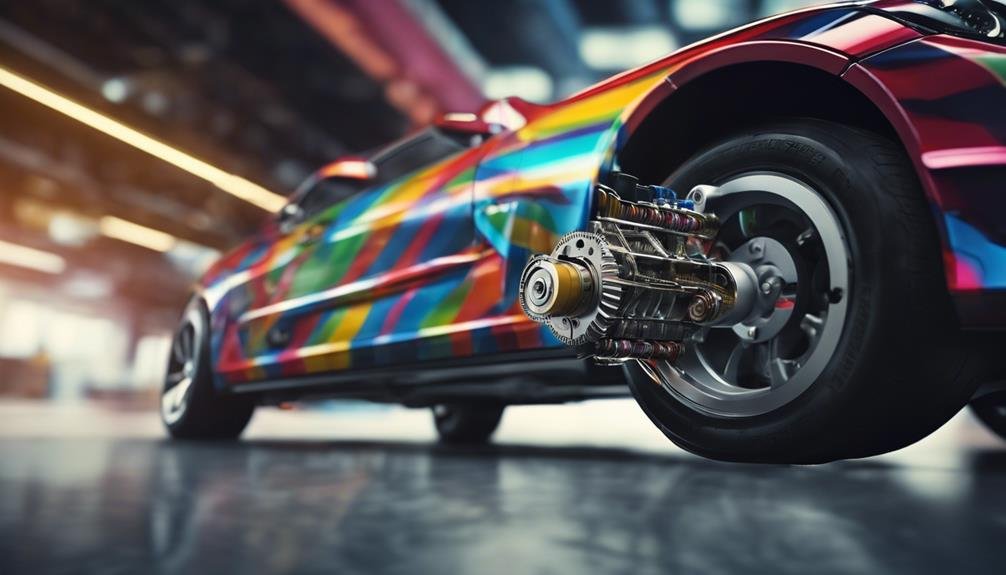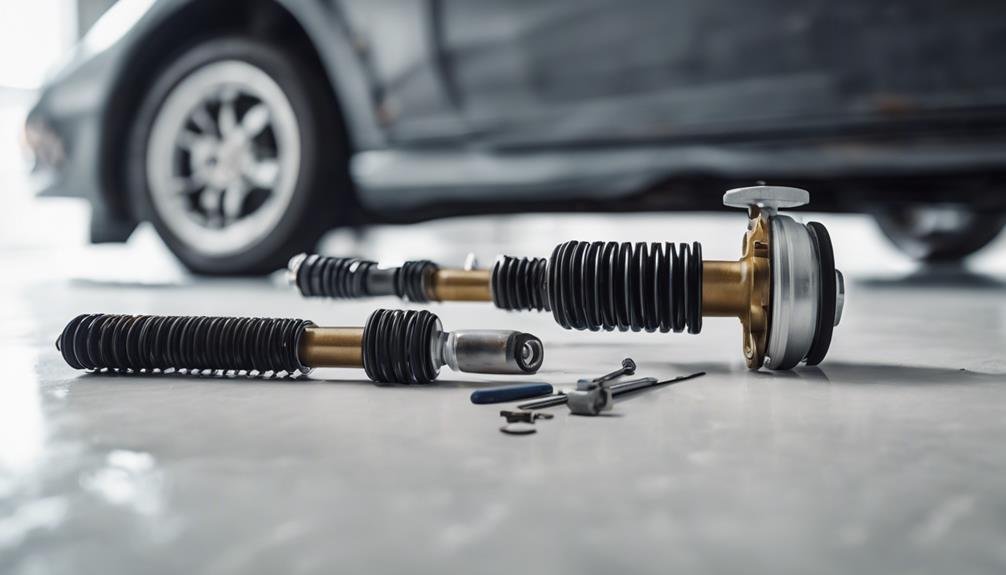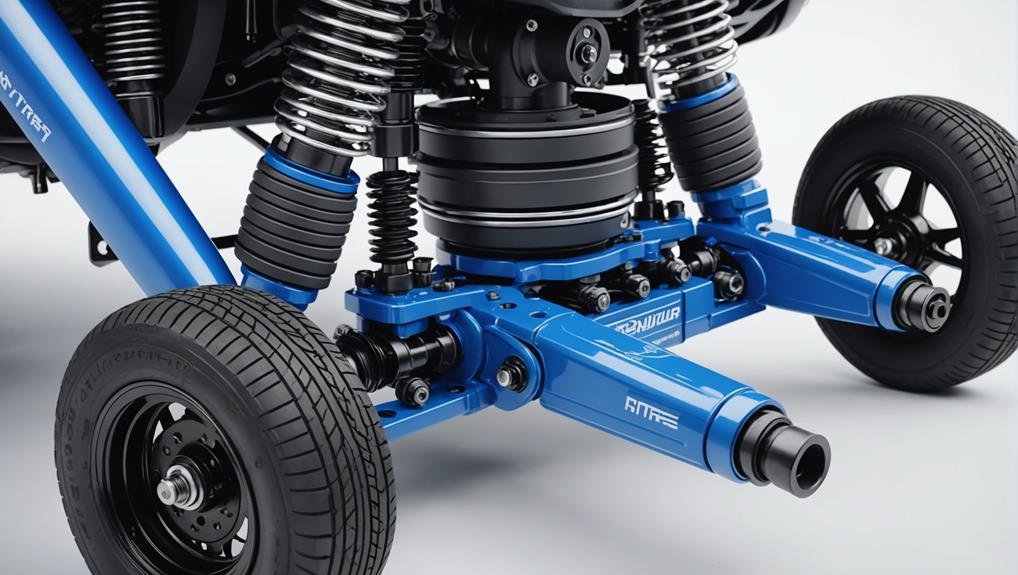As you rely on your vehicle's suspension system to absorb bumps and maintain control, auto struts play a vital role in supporting your vehicle's weight, minimizing bounce, and ensuring a smooth ride. Serving as an essential component, struts absorb impacts, reduce oscillations, and connect the wheel to the vehicle body for stability. They're responsible for a comfortable ride, precise steering, and better braking. By understanding how struts function, you'll appreciate their significance in maintaining your vehicle's overall performance and safety. Now, learn how to identify worn-out struts, the differences between struts and shocks, and more about their importance in your vehicle's suspension system.
Key Takeaways
- Auto struts support vehicle weight, absorb impacts, and provide a smooth ride by minimizing bounce and oscillations.
- Struts connect the wheel to the vehicle body, ensuring stability and maintaining vehicle integrity.
- They are structural components that provide crucial support to the suspension system, influencing steering, braking, and wheel alignment.
- Struts enhance ride quality, vehicle control, and safety by providing a smooth ride and maintaining vehicle stability.
- Functional struts are essential for safety, comfort, and vehicle handling, making regular inspection and replacement crucial.
Understanding Strut Functionality
As you delve into the world of auto struts, it's vital to grasp the fundamental role they play in supporting your vehicle's weight and absorbing impacts. Struts are more than just components of your suspension system; they're the unsung heroes that guarantee a smooth ride, excellent vehicle control, and peak vehicle performance.
A strut assembly typically consists of a coil spring and a shock absorber, which work together to provide structural support and damping. This synergy enables your vehicle to glide over bumps, potholes, and other road imperfections with ease, while maintaining stability and handling.
By minimizing bounce and oscillations, struts have a significant impact on ride quality, making your driving experience more comfortable and enjoyable. Essentially, struts are the backbone of your vehicle's suspension, connecting the wheel to the vehicle body and facilitating seamless communication between the two.
Shocks Vs Struts: Key Differences
When dealing with your vehicle's suspension system, you're often faced with an important decision: choosing between shocks and struts, two components that may seem interchangeable but have distinct roles and benefits. While both play a vital role in your vehicle's suspension, they serve different purposes.
Here are some key differences between shocks and struts:
- Structural vs Non-Structural: Struts are structural components that provide support and connect the wheel to the chassis, whereas shocks are non-structural and focus on controlling spring and suspension movement.
- Dual Function: Struts perform a dual function by supporting the vehicle's weight and absorbing impacts, whereas shocks focus solely on controlling suspension movement.
- Integrated Approach: Struts include a coil spring and shock absorber in one unit, providing a more integrated approach to suspension compared to shocks.
- Ride Comfort and Handling: Struts contribute to better ride quality, improved handling, and improved vehicle control compared to shocks, making them a critical component of your vehicle's suspension system.
What Do Struts Do On A Vehicle

You depend on your vehicle's struts to provide essential support to the suspension system, guaranteeing a smooth ride and maintaining the vehicle's integrity. As you drive, your struts are hard at work, absorbing bumps and impacts to give you a smoother ride.
They provide structural support to the suspension system, which is crucial for maintaining your vehicle's weight and alignment. By doing so, struts play an important role in ensuring your safety on the road. They also contribute to your vehicle's overall performance, influencing steering, braking, and wheel alignment.
Without functional struts, your ride would be rough, and your vehicle's handling would be compromised. So, the next time you're cruising down the highway, keep in mind that your struts are working behind the scenes to keep you safe and comfortable.
Signs of Worn-Out Struts
Worn-out struts often announce their presence through a series of telltale signs that can compromise your vehicle's performance and safety on the road. If you're experiencing any of these signs, it may be time to inspect and maintain your struts to prevent further damage.
Some common signs of worn-out struts include:
- Excessive bouncing over bumps or uneven road surfaces
- Difficulty steering or maintaining control while driving
- Uneven tire wear, especially on the edges
- A clunking or knocking noise when driving over potholes or rough terrain
Additionally, if you notice increased body roll or sway during turns, it could be a symptom of worn-out or damaged struts.
Failing struts can lead to uneven tire wear, reduced handling, and even accidents. Regular maintenance is essential to make sure your vehicle runs smoothly and safely.
Replacing Shocks and Struts

Replacing shocks and struts is an important maintenance task that requires attention at regular intervals to guarantee your vehicle's peak performance and safety.
You know when to replace your shocks and struts when you notice signs of wear, such as increased bumpiness, brake issues, tire wear, and leaks.
Neglecting to replace worn shocks and struts can lead to unstable handling, loss of control, and potential damage to other vehicle components. To avoid this, it's important to have your shocks and struts inspected regularly by an automotive technician.
Remember, struts are two critical components that help maintain your vehicle's stability and ride quality.
When a shock or strut needs to be replaced, it's important to do so promptly to ensure your safety on the road.
Struts play an important role in maintaining your vehicle's balance and stability, so don't hesitate to replace them when necessary.
Maintenance Tips for Struts
To ensure your vehicle's peak performance and safety, it's vital to incorporate regular strut maintenance into your routine. Neglecting strut maintenance can lead to compromised vehicle dynamics, safety, and overall performance.
To avoid this, inspect your struts every 50,000-80,000 miles for signs of wear and tear, such as harsh ride, steering issues, and uneven tire wear.
Here are some important maintenance tips to keep in mind:
- Inspect your struts regularly to catch any signs of wear and tear early on.
- Consider performing a push-down test on your vehicle to check the strut condition.
- Be mindful of the average replacement cost, which ranges from $750-800 for parts and labor.
- Remember, well-functioning struts are crucial for your vehicle's overall safety and performance.
Frequently Asked Questions
What Are the Symptoms of a Bad Strut?
You'll know you've got a bad strut if you notice excessive bouncing, uneven tire wear, steering instability, clunking sounds, or leaking fluid – these symptoms indicate it's time to replace your strut.
How Much Does It Cost to Replace Struts?
You're wondering how much it'll cost to replace your struts? Expect to pay around $750 to $800 for parts and labor, a worthwhile investment to restore your vehicle's ride and handling.
Can You Drive a Car With Bad Struts?
You can drive a car with bad struts, but it's not recommended as it can lead to reduced vehicle control, uneven tire wear, and compromised road safety, putting you and others at risk.
What Does a Strut Do for Your Car?
When you're driving, your struts help absorb road shocks, stabilize your vehicle, and maintain wheel alignment, which enhances your car's general handling, ride comfort, and safety, giving you a smoother and more controlled ride.
Conclusion
As you've learned, struts play a critical role in your vehicle's suspension system, providing stability, handling, and ride comfort.
By understanding the differences between struts and shocks, you can identify signs of wear and tear, and take proactive steps to replace them when necessary.
Regular maintenance and inspections will help extend the life of your struts, ensuring a smoother ride and enhanced overall vehicle performance.
